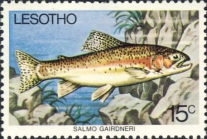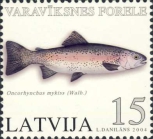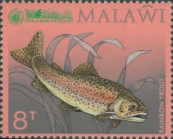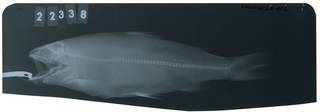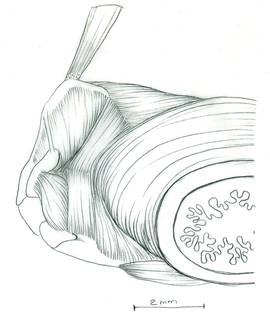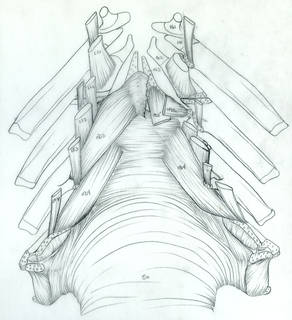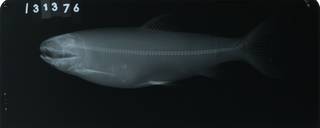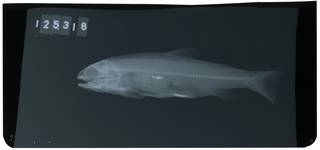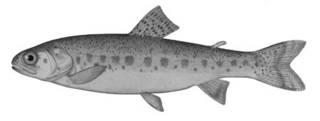WoRMS taxon details
Oncorhynchus mykiss (Walbaum, 1792)
127185 (urn:lsid:marinespecies.org:taxname:127185)
accepted
Species
Fario gairdneri (Richardson, 1836) · unaccepted > junior subjective synonym (also misspelling)
Onchorhynchus mykiss (Walbaum, 1792) · unaccepted > misspelling - incorrect subsequent spelling
Onchorrhychus mykiss (Walbaum, 1792) · unaccepted (misspelling)
Onchorynchus mykiss (Walbaum, 1792) · unaccepted (misspelling)
Oncorhynchus gairdnerii (Richardson, 1836) · unaccepted
Oncorhynchus kamloops Jordan, 1892 · unaccepted
Oncorhynchus mykiss nelsoni (Evermann, 1908) · unaccepted
Oncorhynchus myskis (Walbaum, 1792) · unaccepted (misspelling)
Parasalmo mykiss (Walbaum, 1792) · unaccepted
Parasalmo penshinensis (Pallas, 1814) · unaccepted
Salmo gairdneri Richardson, 1836 · unaccepted > junior subjective synonym (also misspelling)
Salmo gairdneri gairdneri (Richardson, 1836) · unaccepted > junior subjective synonym (also misspelling)
Salmo gairdneri irideus Gibbons, 1855 · unaccepted
Salmo gairdneri kamloops (Jordan, 1892) · unaccepted (junior synonym)
Salmo gairdneri shasta Jordan, 1894 · unaccepted
Salmo gairdneri var. gilberti Jordan, 1894 · unaccepted
Salmo gairdnerii Richardson, 1836 · unaccepted > junior subjective synonym
Salmo gairdnerii gairdnerii Richardson, 1836 · unaccepted
Salmo gairdnerii irideus Gibbons, 1855 · unaccepted
Salmo gilberti Jordan, 1894 · unaccepted
Salmo iridea Gibbons, 1855 · unaccepted
Salmo irideus Gibbons, 1855 · unaccepted
Salmo irideus argentatus Bajkov, 1927 · unaccepted
Salmo irideux Gibbons, 1855 · unaccepted > misspelling - incorrect subsequent spelling
Salmo kamloops (Jordan, 1892) · unaccepted
Salmo kamloops whitehousei Dymond, 1931 · unaccepted
Salmo masoni Suckley, 1860 · unaccepted
Salmo mykiss Walbaum, 1792 · unaccepted
Salmo nelsoni Evermann, 1908 · unaccepted
Salmo penshinensis Pallas, 1814 · unaccepted
Salmo purpuratus Pallas, 1814 · unaccepted (synonym)
Salmo rivularis Ayres, 1855 · unaccepted
Salmo rivularis kamloops (Jordan, 1892) · unaccepted
Salmo truncatus Suckley, 1859 · unaccepted
Salmono gairdneri Richardson, 1836 · unaccepted > misspelling - incorrect subsequent spelling
Trutta iridea (Gibbons, 1855) · unaccepted
- Subspecies Oncorhynchus mykiss nelsoni (Evermann, 1908) accepted as Oncorhynchus mykiss (Walbaum, 1792)
marine, brackish, fresh, terrestrial
(of Salmo mykiss Walbaum, 1792) Walbaum, J. J. (1792). Petri Artedi sueci genera piscium. In quibus systema totum ichthyologiae proponitur cum classibus, ordinibus, generum characteribus, specierum differentiis, observationibus plurimis. Redactis speciebus 242 ad genera 52. Ichthyologiae pars III. <em>Ant. Ferdin. Rose, Grypeswaldiae [Greifswald].</em> Part 3: [i-viii] + 1-723, Pls. 1-3.
page(s): 59 [details]
page(s): 59 [details]
Description The natural habitat of the species is freshwater with about 12°C in summer. It is unclear whether its anadromy is a truly...
Distribution Native to the Pacific coastal inland waters. Introduced into the Atlantic drainages.
Description The natural habitat of the species is freshwater with about 12°C in summer. It is unclear whether its anadromy is a truly genetic adaptation or simply an opportunistic behavior. It seems that any stock of rainbow trout is capable of migrating, or at least adapting to seawater, if the need or opportunity arises. Adults feed upon fish eggs, minnow and other small fish (including other trout); young feed on small insects and crustaceans. Utilized fresh, smoked, canned and frozen; eaten steamed, fried, broiled, boiled, microwaved and baked (Ref. 9988). Rainbow trout is cultured in many countries and is often hatched and stocked into rivers and lake especially to attract recreational fishermen (Ref. 9988). [details]
Distribution Native to the Pacific coastal inland waters. Introduced into the Atlantic drainages.
Distribution Native to the Pacific coastal inland waters. Introduced into the Atlantic drainages. [details]
Froese, R. and D. Pauly. Editors. (2024). FishBase. Oncorhynchus mykiss (Walbaum, 1792). Accessed through: World Register of Marine Species at: https://www.marinespecies.org/aphia.php?p=taxdetails&id=127185 on 2024-11-21
Date
action
by
![]() The webpage text is licensed under a Creative Commons Attribution-Noncommercial 4.0 License
The webpage text is licensed under a Creative Commons Attribution-Noncommercial 4.0 License
original description
(of Salmo gairdneri Richardson, 1836) Richardson, J. (1836). The Fish. In: Fauna Boreali-Americana; or the zoology of the northern parts of British America: containing descriptions of the objects of natural history collected on the late northern land expeditions, under the command of Sir John Franklin, R.N. <em>J. Bentley, London.</em> Part 3: i-xv + 1-327, Pls. 74-97. [Reference was incorrectly given as 1837; correct date is 1836 (WNE June 12, 2015).]. [details]
original description (of Salmo truncatus Suckley, 1859) Suckley, G. (1859). Descriptions of several new species of Salmonidae, from the North-West Coast of America. <em>Annals of the Lyceum of Natural History of New York.</em> v. 7 (art. 1): 1-10. [details]
original description (of Salmo mykiss Walbaum, 1792) Walbaum, J. J. (1792). Petri Artedi sueci genera piscium. In quibus systema totum ichthyologiae proponitur cum classibus, ordinibus, generum characteribus, specierum differentiis, observationibus plurimis. Redactis speciebus 242 ad genera 52. Ichthyologiae pars III. <em>Ant. Ferdin. Rose, Grypeswaldiae [Greifswald].</em> Part 3: [i-viii] + 1-723, Pls. 1-3.
page(s): 59 [details]
original description (of Salmo penshinensis Pallas, 1814) Pallas, P. S. (1814). Zoographia Rosso-Asiatica, sistens omnium animalium in extenso Imperio Rossico et adjacentibus maribus observatorum recensionem, domicilia, mores et descriptiones anatomen atque icones plurimorum.3 vols.[1811-1814]. <em>Academia Scientiarum, Petropolis [Sankt Petersburg].</em> v. 3: i-vii + 1-428 + index (I-CXXV), Pls. 1, 13, 14, 15, 20 and 21.
page(s): 381 [details]
original description (of Salmo purpuratus Pallas, 1814) Pallas, P. S. (1814). Zoographia Rosso-Asiatica, sistens omnium animalium in extenso Imperio Rossico et adjacentibus maribus observatorum recensionem, domicilia, mores et descriptiones anatomen atque icones plurimorum.3 vols.[1811-1814]. <em>Academia Scientiarum, Petropolis [Sankt Petersburg].</em> v. 3: i-vii + 1-428 + index (I-CXXV), Pls. 1, 13, 14, 15, 20 and 21.
page(s): 374 [details]
original description (of Salmo rivularis Ayres, 1855) Ayres, W. O. (1855). [Description of new fishes from California.]. <em>(Minutes of Academy meetings were printed in "The Pacific" (a newspaper) shortly after each meeting. New species date to publication in The Pacific. Dates of publication are given in each species account). The Pacific [newspaper].</em> v. 4 (nos 7-22). [Also appeared in Proc. Calif. Acad. Nat. Sci. v. 1.]. [details]
context source (Introduced species) Katsanevakis, S.; Bogucarskis, K.; Gatto, F.; Vandekerkhove, J.; Deriu, I.; Cardoso A.S. (2012). Building the European Alien Species Information Network (EASIN): a novel approach for the exploration of distributed alien species data. <em>BioInvasions Records.</em> 1: 235-245., available online at http://easin.jrc.ec.europa.eu [details] Available for editors [request]
[request]
context source (HKRMS) Leung KMY., Chu JCW. & Wu RSS. (2003).Reducing nitrogen pollution loading from fish farming by changing feeding practices: an example from Hong Kong. In: Morton B, editor. Proceedings of an International Workshop Reunion Conference, Hong Kong: Perspectives on Marine Environment Change in Hong Kong and Southern China, 1977-2001. Hong Kong University Press, Hong Kong. pp 543-554. [details]
context source (RAS) Australian Antarctic Data Centre. , available online at https://data.aad.gov.au/aadc/biodiversity/ [details]
context source (Schelde) Breine, J.; Van Thuyne, G. (2014). Opvolging van het visbestand in de Zeeschelde: Viscampagnes 2013. <em>Rapporten van het Instituut voor Natuur- en Bosonderzoek, INBO.R.2014.1413950. Instituut voor Natuur- en Bosonderzoek (INBO): Brussel.</em> 52 pp. (look up in IMIS) [details]
basis of record van der Land, J.; Costello, M.J.; Zavodnik, D.; Santos, R.S.; Porteiro, F.M.; Bailly, N.; Eschmeyer, W.N.; Froese, R. (2001). Pisces, <B><I>in</I></B>: Costello, M.J. <i>et al.</i> (Ed.) (2001). <i>European register of marine species: a check-list of the marine species in Europe and a bibliography of guides to their identification. Collection Patrimoines Naturels,</i> 50: pp. 357-374 (look up in IMIS) [details]
additional source Scott, W.B.; Scott, M.G. (1988). Atlantic fishes of Canada. <em>Canadian Bulletin of Fisheries and Aquatic Sciences.</em> No. 219. 731 pp. [details]
additional source Streftaris, N., A. Zenetos & E. Papathanassiou. (2005). Globalisation in marine ecosystems: the story of non-indigenous marine species across European seas. <em>Oceanogry and Marine Biology: an Annual Review.</em> 43: 419-453. (look up in IMIS) [details] Available for editors [request]
[request]
additional source King, C.M.; Roberts, C.D.; Bell, B.D.; Fordyce, R.E.; Nicoll, R.S.; Worthy, T.H.; Paulin, C.D.; Hitchmough, R.A.; Keyes, I.W.; Baker, A.N.; Stewart, A.L.; Hiller, N.; McDowall, R.M.; Holdaway, R.N.; McPhee, R.P.; Schwarzhans, W.W.; Tennyson, A.J.D.; Rust, S.; Macadie, I. (2009). Phylum Chordata: lancelets, fishes, amphibians, reptiles, birds, mammals. <em>in: Gordon, D.P. (Ed.) (2009). New Zealand inventory of biodiversity: 1. Kingdom Animalia: Radiata, Lophotrochozoa, Deuterostomia.</em> pp. 431-554. [details]
additional source Lutaenko, K.A.; Furota, T.; Nakayama; S.; Shin, K.; Xu, J. (2013). Atlas of Marine Invasive Species in the NOWPAP Region. Beijing: NOWPAP DINRAC (Northwest Pacific Action Plan, Data and Information Network Regional Center). 189 pp. [details]
additional source Fricke, R., Eschmeyer, W. N. & Van der Laan, R. (eds). (2024). ECoF. Eschmeyer's Catalog of Fishes: Genera, Species, References. <em>California Academy of Sciences. San Francisco.</em> Electronic version accessed dd mmm 2024., available online at http://researcharchive.calacademy.org/research/Ichthyology/catalog/fishcatmain.asp [details]
additional source Artedi, P.; Linnaeus, C. V.; Walbaum, J. J. (1792). Petri Artedi Sueci Genera piscium : in quibus systema totum ichthyologiae proponitur cum classibus, ordinibus, generum characteribus, specierum differentiis, observationibus plurimis : redactis speciebus 242 ad genera 52 : Ichthyologiae. , available online at https://www.biodiversitylibrary.org/bibliography/61537#/summary
page(s): 59 [details]
additional source Froese, R. & D. Pauly (Editors). (2024). FishBase. World Wide Web electronic publication. version (06/2024)., available online at https://www.fishbase.org [details]
ecology source Looby, A.; Erbe, C.; Bravo, S.; Cox, K.; Davies, H. L.; Di Iorio, L.; Jézéquel, Y.; Juanes, F.; Martin, C. W.; Mooney, T. A.; Radford, C.; Reynolds, L. K.; Rice, A. N.; Riera, A.; Rountree, R.; Spriel, B.; Stanley, J.; Vela, S.; Parsons, M. J. G. (2023). Global inventory of species categorized by known underwater sonifery. <em>Scientific Data.</em> 10(1). (look up in IMIS), available online at https://doi.org/10.1038/s41597-023-02745-4 [details]
original description (of Salmo truncatus Suckley, 1859) Suckley, G. (1859). Descriptions of several new species of Salmonidae, from the North-West Coast of America. <em>Annals of the Lyceum of Natural History of New York.</em> v. 7 (art. 1): 1-10. [details]
original description (of Salmo mykiss Walbaum, 1792) Walbaum, J. J. (1792). Petri Artedi sueci genera piscium. In quibus systema totum ichthyologiae proponitur cum classibus, ordinibus, generum characteribus, specierum differentiis, observationibus plurimis. Redactis speciebus 242 ad genera 52. Ichthyologiae pars III. <em>Ant. Ferdin. Rose, Grypeswaldiae [Greifswald].</em> Part 3: [i-viii] + 1-723, Pls. 1-3.
page(s): 59 [details]
original description (of Salmo penshinensis Pallas, 1814) Pallas, P. S. (1814). Zoographia Rosso-Asiatica, sistens omnium animalium in extenso Imperio Rossico et adjacentibus maribus observatorum recensionem, domicilia, mores et descriptiones anatomen atque icones plurimorum.3 vols.[1811-1814]. <em>Academia Scientiarum, Petropolis [Sankt Petersburg].</em> v. 3: i-vii + 1-428 + index (I-CXXV), Pls. 1, 13, 14, 15, 20 and 21.
page(s): 381 [details]
original description (of Salmo purpuratus Pallas, 1814) Pallas, P. S. (1814). Zoographia Rosso-Asiatica, sistens omnium animalium in extenso Imperio Rossico et adjacentibus maribus observatorum recensionem, domicilia, mores et descriptiones anatomen atque icones plurimorum.3 vols.[1811-1814]. <em>Academia Scientiarum, Petropolis [Sankt Petersburg].</em> v. 3: i-vii + 1-428 + index (I-CXXV), Pls. 1, 13, 14, 15, 20 and 21.
page(s): 374 [details]
original description (of Salmo rivularis Ayres, 1855) Ayres, W. O. (1855). [Description of new fishes from California.]. <em>(Minutes of Academy meetings were printed in "The Pacific" (a newspaper) shortly after each meeting. New species date to publication in The Pacific. Dates of publication are given in each species account). The Pacific [newspaper].</em> v. 4 (nos 7-22). [Also appeared in Proc. Calif. Acad. Nat. Sci. v. 1.]. [details]
context source (Introduced species) Katsanevakis, S.; Bogucarskis, K.; Gatto, F.; Vandekerkhove, J.; Deriu, I.; Cardoso A.S. (2012). Building the European Alien Species Information Network (EASIN): a novel approach for the exploration of distributed alien species data. <em>BioInvasions Records.</em> 1: 235-245., available online at http://easin.jrc.ec.europa.eu [details] Available for editors
context source (HKRMS) Leung KMY., Chu JCW. & Wu RSS. (2003).Reducing nitrogen pollution loading from fish farming by changing feeding practices: an example from Hong Kong. In: Morton B, editor. Proceedings of an International Workshop Reunion Conference, Hong Kong: Perspectives on Marine Environment Change in Hong Kong and Southern China, 1977-2001. Hong Kong University Press, Hong Kong. pp 543-554. [details]
context source (RAS) Australian Antarctic Data Centre. , available online at https://data.aad.gov.au/aadc/biodiversity/ [details]
context source (Schelde) Breine, J.; Van Thuyne, G. (2014). Opvolging van het visbestand in de Zeeschelde: Viscampagnes 2013. <em>Rapporten van het Instituut voor Natuur- en Bosonderzoek, INBO.R.2014.1413950. Instituut voor Natuur- en Bosonderzoek (INBO): Brussel.</em> 52 pp. (look up in IMIS) [details]
basis of record van der Land, J.; Costello, M.J.; Zavodnik, D.; Santos, R.S.; Porteiro, F.M.; Bailly, N.; Eschmeyer, W.N.; Froese, R. (2001). Pisces, <B><I>in</I></B>: Costello, M.J. <i>et al.</i> (Ed.) (2001). <i>European register of marine species: a check-list of the marine species in Europe and a bibliography of guides to their identification. Collection Patrimoines Naturels,</i> 50: pp. 357-374 (look up in IMIS) [details]
additional source Scott, W.B.; Scott, M.G. (1988). Atlantic fishes of Canada. <em>Canadian Bulletin of Fisheries and Aquatic Sciences.</em> No. 219. 731 pp. [details]
additional source Streftaris, N., A. Zenetos & E. Papathanassiou. (2005). Globalisation in marine ecosystems: the story of non-indigenous marine species across European seas. <em>Oceanogry and Marine Biology: an Annual Review.</em> 43: 419-453. (look up in IMIS) [details] Available for editors
additional source King, C.M.; Roberts, C.D.; Bell, B.D.; Fordyce, R.E.; Nicoll, R.S.; Worthy, T.H.; Paulin, C.D.; Hitchmough, R.A.; Keyes, I.W.; Baker, A.N.; Stewart, A.L.; Hiller, N.; McDowall, R.M.; Holdaway, R.N.; McPhee, R.P.; Schwarzhans, W.W.; Tennyson, A.J.D.; Rust, S.; Macadie, I. (2009). Phylum Chordata: lancelets, fishes, amphibians, reptiles, birds, mammals. <em>in: Gordon, D.P. (Ed.) (2009). New Zealand inventory of biodiversity: 1. Kingdom Animalia: Radiata, Lophotrochozoa, Deuterostomia.</em> pp. 431-554. [details]
additional source Lutaenko, K.A.; Furota, T.; Nakayama; S.; Shin, K.; Xu, J. (2013). Atlas of Marine Invasive Species in the NOWPAP Region. Beijing: NOWPAP DINRAC (Northwest Pacific Action Plan, Data and Information Network Regional Center). 189 pp. [details]
additional source Fricke, R., Eschmeyer, W. N. & Van der Laan, R. (eds). (2024). ECoF. Eschmeyer's Catalog of Fishes: Genera, Species, References. <em>California Academy of Sciences. San Francisco.</em> Electronic version accessed dd mmm 2024., available online at http://researcharchive.calacademy.org/research/Ichthyology/catalog/fishcatmain.asp [details]
additional source Artedi, P.; Linnaeus, C. V.; Walbaum, J. J. (1792). Petri Artedi Sueci Genera piscium : in quibus systema totum ichthyologiae proponitur cum classibus, ordinibus, generum characteribus, specierum differentiis, observationibus plurimis : redactis speciebus 242 ad genera 52 : Ichthyologiae. , available online at https://www.biodiversitylibrary.org/bibliography/61537#/summary
page(s): 59 [details]
additional source Froese, R. & D. Pauly (Editors). (2024). FishBase. World Wide Web electronic publication. version (06/2024)., available online at https://www.fishbase.org [details]
ecology source Looby, A.; Erbe, C.; Bravo, S.; Cox, K.; Davies, H. L.; Di Iorio, L.; Jézéquel, Y.; Juanes, F.; Martin, C. W.; Mooney, T. A.; Radford, C.; Reynolds, L. K.; Rice, A. N.; Riera, A.; Rountree, R.; Spriel, B.; Stanley, J.; Vela, S.; Parsons, M. J. G. (2023). Global inventory of species categorized by known underwater sonifery. <em>Scientific Data.</em> 10(1). (look up in IMIS), available online at https://doi.org/10.1038/s41597-023-02745-4 [details]
 Present
Present  Present in aphia/obis/gbif/idigbio
Present in aphia/obis/gbif/idigbio  Inaccurate
Inaccurate  Introduced: alien
Introduced: alien  Containing type locality
Containing type locality
From regional or thematic species database
Introduced species impact in Portugal (Nation) : Other impact - undefined or uncertain [details]Introduced species impact in Belgian part of the North Sea : Other impact - undefined or uncertain [details]
Introduced species impact in Celtic Sea (IHO Sea Area) : Consumes native species (predator or herbivore) [details]
Introduced species impact Chinese part of the Yellow Sea (Marine Region) Outcompetes native species for resources and/or space [details]
Introduced species impact Chinese part of the Yellow Sea (Marine Region) Genetic impacts: hybridisation and introgression [details]
Introduced species impact Chinese part of the Yellow Sea (Marine Region) Consumes native species (predator or herbivore) [details]
Introduced species vector dispersal Uruguayan part of the South Atlantic Ocean (Marine Region) Aquaculture: Accidental [details]
Introduced species vector dispersal in Celtic Sea (IHO Sea Area) : Fisheries: deliberate translocations of fish or shellfish to establish or support fishery [details]
Introduced species vector dispersal in Belgian part of the North Sea : Fisheries: deliberate translocations of fish or shellfish to establish or support fishery [details]
Introduced species vector dispersal Chinese part of the Yellow Sea (Marine Region) Aquaculture [details]
Introduced species vector dispersal Argentinean part of the South Atlantic Ocean (Marine Region) Aquaculture: Accidental [details]
Introduced species vector dispersal in France (Nation) : Fisheries: deliberate translocations of fish or shellfish to establish or support fishery [details]
Unreviewed
Description The natural habitat of the species is freshwater with about 12°C in summer. It is unclear whether its anadromy is a truly genetic adaptation or simply an opportunistic behavior. It seems that any stock of rainbow trout is capable of migrating, or at least adapting to seawater, if the need or opportunity arises. Adults feed upon fish eggs, minnow and other small fish (including other trout); young feed on small insects and crustaceans. Utilized fresh, smoked, canned and frozen; eaten steamed, fried, broiled, boiled, microwaved and baked (Ref. 9988). Rainbow trout is cultured in many countries and is often hatched and stocked into rivers and lake especially to attract recreational fishermen (Ref. 9988). [details]Diet Adults feed on aquatic and terrestial insects, molluscs, crustaceans, fish eggs, minnows, and other small fishes (including other trout); young feed predominantly on zooplankton [details]
Distribution Native to the Pacific coastal inland waters. Introduced into the Atlantic drainages. [details]
Habitat nektonic [details]
Habitat The natural habitat of the species is fresh water with about 12°C in summer. [details]
Importance Scientific- Highly commercial, aquaculture, gamefish [details]
| Language | Name | |
|---|---|---|
| Albanian | trofta e ylbertë [from synonym]trofta e Kalifornisë [from synonym] | [details] |
| Danish | regnbueørred | [details] |
| Dutch | zalmforelregenboogforelforel | [details] |
| English | syeelhead troutsteelhead troutSteelheadrainbow trout | [details] |
| French | truite saumonéetruite arc-en-ciel anadrometruite arc-en-cieltruite | [details] |
| German | RegenbogenforelleLachsforelleForelle | [details] |
| Italian | trotta iridea | [details] |
| Japanese | ニジマス | [details] |
| Norwegian Bokmål | regnbueørret | [details] |
| Norwegian Nynorsk | regnbogeaure | [details] |
| Polish | pstrąg tęczowy | [details] |
| Russian | радужная форельМикижакамчатская семга | [details] |
| Spanish | trucha arcoiris | [details] |
| Swedish | regnbåge | [details] |
| Welsh | brithyll seithliw | [details] |
To Barcode of Life (593 barcodes)
To Biodiversity Heritage Library (1 publication) (from synonym Oncorhynchus mykiss nelsoni (Evermann, 1908))
To Biodiversity Heritage Library (10 publications) (from synonym Salmo gairdneri shasta Jordan, 1894)
To Biodiversity Heritage Library (11 publications) (from synonym Salmo penshinensis Pallas, 1814)
To Biodiversity Heritage Library (111 publications) (from synonym Salmo purpuratus Pallas, 1814)
To Biodiversity Heritage Library (133 publications) (from synonym Salmo mykiss Walbaum, 1792)
To Biodiversity Heritage Library (16 publications) (from synonym Fario gairdneri (Richardson, 1836))
To Biodiversity Heritage Library (20 publications) (from synonym Salmo gairdneri irideus Gibbons, 1855)
To Biodiversity Heritage Library (20 publications) (from synonym Salmo nelsoni Evermann, 1908)
To Biodiversity Heritage Library (21 publications) (from synonym Salmo gilberti Jordan, 1894)
To Biodiversity Heritage Library (22 publications) (from synonym Salmo truncatus Suckley, 1859)
To Biodiversity Heritage Library (24 publications) (from synonym Salmo kamloops (Jordan, 1892))
To Biodiversity Heritage Library (28 publications) (from synonym Salmo masoni Suckley, 1860)
To Biodiversity Heritage Library (3 publications) (from synonym Oncorhynchus kamloops Jordan, 1892)
To Biodiversity Heritage Library (3 publications) (from synonym Salmo rivularis kamloops (Jordan, 1892))
To Biodiversity Heritage Library (36 publications) (from synonym Salmo rivularis Ayres, 1855)
To Biodiversity Heritage Library (392 publications) (from synonym Salmo gairdneri Richardson, 1836)
To Biodiversity Heritage Library (431 publications) (from synonym Salmo irideus Gibbons, 1855)
To Biodiversity Heritage Library (5 publications) (from synonym Onchorynchus mykiss (Walbaum, 1792))
To Biodiversity Heritage Library (50 publications) (from synonym Trutta iridea (Gibbons, 1855))
To Biodiversity Heritage Library (52 publications) (from synonym Salmo iridea Gibbons, 1855)
To Biodiversity Heritage Library (75 publications)
To Biodiversity Heritage Library (8 publications) (from synonym Salmo gairdnerii gairdnerii Richardson, 1836)
To Biodiversity Heritage Library (9 publications) (from synonym Salmo gairdnerii irideus Gibbons, 1855)
To Biodiversity Heritage Library (90 publications) (from synonym Salmo gairdnerii Richardson, 1836)
To Biological Information System for Marine Life (BISMaL) (from synonym Salmo gairdneri Richardson, 1836)
To Biological Information System for Marine Life (BISMaL)
To European Nucleotide Archive, ENA (Oncorhynchus mykiss nelsoni) (from synonym Oncorhynchus mykiss nelsoni (Evermann, 1908))
To European Nucleotide Archive, ENA (Oncorhynchus mykiss)
To FAO Cultured Aquatic species fact sheets
To FishBase
To FishBase (from synonym Salmo gairdneri Richardson, 1836)
To FishBase (from synonym Oncorhynchus gairdnerii (Richardson, 1836))
To FishBase (from synonym Oncorhynchus kamloops Jordan, 1892)
To FishBase (from synonym Salmo gairdnerii Richardson, 1836)
To FishBase (from synonym Salmo iridea Gibbons, 1855)
To FishBase (from synonym Salmo gilberti Jordan, 1894)
To FishBase (from synonym Salmo gairdneri irideus Gibbons, 1855)
To FishBase (from synonym Oncorhynchus mykiss nelsoni (Evermann, 1908))
To FishBase (from synonym Salmo truncatus Suckley, 1859)
To FishBase (from synonym Fario gairdneri (Richardson, 1836))
To FishBase (from synonym Parasalmo mykiss (Walbaum, 1792))
To FishBase (from synonym Parasalmo penshinensis (Pallas, 1814))
To FishBase (from synonym Trutta iridea (Gibbons, 1855))
To FishBase (from synonym Salmo mykiss Walbaum, 1792)
To FishBase (from synonym Salmo masoni Suckley, 1860)
To FishBase (from synonym Salmo irideus Gibbons, 1855)
To FishBase (from synonym Salmo kamloops (Jordan, 1892))
To FishBase (from synonym Salmo nelsoni Evermann, 1908)
To FishBase (from synonym Salmo rivularis Ayres, 1855)
To FishBase (from synonym Salmo purpuratus Pallas, 1814)
To FishBase (from synonym Salmo irideus argentatus Bajkov, 1927)
To FishBase (from synonym Salmo kamloops whitehousei Dymond, 1931)
To FishBase (from synonym Salmo rivularis kamloops (Jordan, 1892))
To FishBase (from synonym Salmo penshinensis Pallas, 1814)
To FishBase (from synonym Salmo gairdneri shasta Jordan, 1894)
To FishBase (from synonym Salmo gairdnerii irideus Gibbons, 1855)
To FishBase (from synonym Salmo gairdnerii gairdnerii Richardson, 1836)
To FishBase (from synonym Onchorrhychus mykiss (Walbaum, 1792))
To FishBase (from synonym Oncorhynchus myskis (Walbaum, 1792))
To FishBase (from synonym Onchorynchus mykiss (Walbaum, 1792))
To FishBase images (Oncorhynchus mykiss, Sri Lanka, by Ramani Shirantha)
To Fishipedia
To FishSounds
To GenBank (1 nucleotides; 13 proteins) (from synonym Salmo nelsoni Evermann, 1908)
To GenBank (1 nucleotides; 13 proteins) (from synonym Oncorhynchus mykiss nelsoni (Evermann, 1908))
To GenBank (1452774 nucleotides; 152145 proteins) (from synonym Parasalmo mykiss (Walbaum, 1792))
To GenBank (1452774 nucleotides; 152145 proteins) (from synonym Salmo mykiss Walbaum, 1792)
To GenBank (1452774 nucleotides; 152145 proteins)
To GenBank (3207 nucleotides; 65 proteins) (from synonym Salmo gairdnerii Richardson, 1836)
To GenBank (3207 nucleotides; 65 proteins) (from synonym Salmo gairdneri Richardson, 1836)
To GenBank (63 nucleotides; 41 proteins) (from synonym Salmo iridea Gibbons, 1855)
To GenBank (63 nucleotides; 41 proteins) (from synonym Salmo irideus Gibbons, 1855)
To Global Biotic Interactions (GloBI)
To Global Invasive Species Database (GISD)
To Information system on Aquatic Non-Indigenous and Cryptogenic Species (AquaNIS)
To IUCN Red List (Least Concern)
To NMNH Extant Collection (Oncorhynchus mykiss gairdnerii RAD104029-001) (from synonym Salmo gairdnerii Richardson, 1836)
To NMNH Extant Collection (Oncorhynchus mykiss P16428 illustration)
To NMNH Extant Collection (Oncorhynchus mykiss RAD104034-001) (from synonym Salmo gairdneri shasta Jordan, 1894)
To NMNH Extant Collection (Oncorhynchus mykiss RAD104049-001) (from synonym Salmo gairdneri irideus Gibbons, 1855)
To NMNH Extant Collection (Salmo irrideus P07908 illustration) (from synonym Salmo gairdneri irideus Gibbons, 1855)
To NMNH Extant Collection (Salmo nelsoni RAD104040-001) (from synonym Salmo nelsoni Evermann, 1908)
To NMNH Extant Collection (Salmo nelsoni RAD104040-001) (from synonym Salmo nelsoni Evermann, 1908)
To PESI
To ITIS
To Biodiversity Heritage Library (1 publication) (from synonym Oncorhynchus mykiss nelsoni (Evermann, 1908))
To Biodiversity Heritage Library (10 publications) (from synonym Salmo gairdneri shasta Jordan, 1894)
To Biodiversity Heritage Library (11 publications) (from synonym Salmo penshinensis Pallas, 1814)
To Biodiversity Heritage Library (111 publications) (from synonym Salmo purpuratus Pallas, 1814)
To Biodiversity Heritage Library (133 publications) (from synonym Salmo mykiss Walbaum, 1792)
To Biodiversity Heritage Library (16 publications) (from synonym Fario gairdneri (Richardson, 1836))
To Biodiversity Heritage Library (20 publications) (from synonym Salmo gairdneri irideus Gibbons, 1855)
To Biodiversity Heritage Library (20 publications) (from synonym Salmo nelsoni Evermann, 1908)
To Biodiversity Heritage Library (21 publications) (from synonym Salmo gilberti Jordan, 1894)
To Biodiversity Heritage Library (22 publications) (from synonym Salmo truncatus Suckley, 1859)
To Biodiversity Heritage Library (24 publications) (from synonym Salmo kamloops (Jordan, 1892))
To Biodiversity Heritage Library (28 publications) (from synonym Salmo masoni Suckley, 1860)
To Biodiversity Heritage Library (3 publications) (from synonym Oncorhynchus kamloops Jordan, 1892)
To Biodiversity Heritage Library (3 publications) (from synonym Salmo rivularis kamloops (Jordan, 1892))
To Biodiversity Heritage Library (36 publications) (from synonym Salmo rivularis Ayres, 1855)
To Biodiversity Heritage Library (392 publications) (from synonym Salmo gairdneri Richardson, 1836)
To Biodiversity Heritage Library (431 publications) (from synonym Salmo irideus Gibbons, 1855)
To Biodiversity Heritage Library (5 publications) (from synonym Onchorynchus mykiss (Walbaum, 1792))
To Biodiversity Heritage Library (50 publications) (from synonym Trutta iridea (Gibbons, 1855))
To Biodiversity Heritage Library (52 publications) (from synonym Salmo iridea Gibbons, 1855)
To Biodiversity Heritage Library (75 publications)
To Biodiversity Heritage Library (8 publications) (from synonym Salmo gairdnerii gairdnerii Richardson, 1836)
To Biodiversity Heritage Library (9 publications) (from synonym Salmo gairdnerii irideus Gibbons, 1855)
To Biodiversity Heritage Library (90 publications) (from synonym Salmo gairdnerii Richardson, 1836)
To Biological Information System for Marine Life (BISMaL) (from synonym Salmo gairdneri Richardson, 1836)
To Biological Information System for Marine Life (BISMaL)
To European Nucleotide Archive, ENA (Oncorhynchus mykiss nelsoni) (from synonym Oncorhynchus mykiss nelsoni (Evermann, 1908))
To European Nucleotide Archive, ENA (Oncorhynchus mykiss)
To FAO Cultured Aquatic species fact sheets
To FishBase
To FishBase (from synonym Salmo gairdneri Richardson, 1836)
To FishBase (from synonym Oncorhynchus gairdnerii (Richardson, 1836))
To FishBase (from synonym Oncorhynchus kamloops Jordan, 1892)
To FishBase (from synonym Salmo gairdnerii Richardson, 1836)
To FishBase (from synonym Salmo iridea Gibbons, 1855)
To FishBase (from synonym Salmo gilberti Jordan, 1894)
To FishBase (from synonym Salmo gairdneri irideus Gibbons, 1855)
To FishBase (from synonym Oncorhynchus mykiss nelsoni (Evermann, 1908))
To FishBase (from synonym Salmo truncatus Suckley, 1859)
To FishBase (from synonym Fario gairdneri (Richardson, 1836))
To FishBase (from synonym Parasalmo mykiss (Walbaum, 1792))
To FishBase (from synonym Parasalmo penshinensis (Pallas, 1814))
To FishBase (from synonym Trutta iridea (Gibbons, 1855))
To FishBase (from synonym Salmo mykiss Walbaum, 1792)
To FishBase (from synonym Salmo masoni Suckley, 1860)
To FishBase (from synonym Salmo irideus Gibbons, 1855)
To FishBase (from synonym Salmo kamloops (Jordan, 1892))
To FishBase (from synonym Salmo nelsoni Evermann, 1908)
To FishBase (from synonym Salmo rivularis Ayres, 1855)
To FishBase (from synonym Salmo purpuratus Pallas, 1814)
To FishBase (from synonym Salmo irideus argentatus Bajkov, 1927)
To FishBase (from synonym Salmo kamloops whitehousei Dymond, 1931)
To FishBase (from synonym Salmo rivularis kamloops (Jordan, 1892))
To FishBase (from synonym Salmo penshinensis Pallas, 1814)
To FishBase (from synonym Salmo gairdneri shasta Jordan, 1894)
To FishBase (from synonym Salmo gairdnerii irideus Gibbons, 1855)
To FishBase (from synonym Salmo gairdnerii gairdnerii Richardson, 1836)
To FishBase (from synonym Onchorrhychus mykiss (Walbaum, 1792))
To FishBase (from synonym Oncorhynchus myskis (Walbaum, 1792))
To FishBase (from synonym Onchorynchus mykiss (Walbaum, 1792))
To FishBase images (Oncorhynchus mykiss, Sri Lanka, by Ramani Shirantha)
To Fishipedia
To FishSounds
To GenBank (1 nucleotides; 13 proteins) (from synonym Salmo nelsoni Evermann, 1908)
To GenBank (1 nucleotides; 13 proteins) (from synonym Oncorhynchus mykiss nelsoni (Evermann, 1908))
To GenBank (1452774 nucleotides; 152145 proteins) (from synonym Parasalmo mykiss (Walbaum, 1792))
To GenBank (1452774 nucleotides; 152145 proteins) (from synonym Salmo mykiss Walbaum, 1792)
To GenBank (1452774 nucleotides; 152145 proteins)
To GenBank (3207 nucleotides; 65 proteins) (from synonym Salmo gairdnerii Richardson, 1836)
To GenBank (3207 nucleotides; 65 proteins) (from synonym Salmo gairdneri Richardson, 1836)
To GenBank (63 nucleotides; 41 proteins) (from synonym Salmo iridea Gibbons, 1855)
To GenBank (63 nucleotides; 41 proteins) (from synonym Salmo irideus Gibbons, 1855)
To Global Biotic Interactions (GloBI)
To Global Invasive Species Database (GISD)
To Information system on Aquatic Non-Indigenous and Cryptogenic Species (AquaNIS)
To IUCN Red List (Least Concern)
To NMNH Extant Collection (Oncorhynchus mykiss gairdnerii RAD104029-001) (from synonym Salmo gairdnerii Richardson, 1836)
To NMNH Extant Collection (Oncorhynchus mykiss P16428 illustration)
To NMNH Extant Collection (Oncorhynchus mykiss RAD104034-001) (from synonym Salmo gairdneri shasta Jordan, 1894)
To NMNH Extant Collection (Oncorhynchus mykiss RAD104049-001) (from synonym Salmo gairdneri irideus Gibbons, 1855)
To NMNH Extant Collection (Salmo irrideus P07908 illustration) (from synonym Salmo gairdneri irideus Gibbons, 1855)
To NMNH Extant Collection (Salmo nelsoni RAD104040-001) (from synonym Salmo nelsoni Evermann, 1908)
To NMNH Extant Collection (Salmo nelsoni RAD104040-001) (from synonym Salmo nelsoni Evermann, 1908)
To PESI
To ITIS
From editor or global species database
Unreviewed


